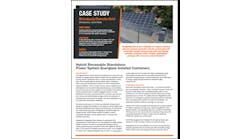Case study: How Alencon Systems brought efficiency and sustainability to the American Geophysical Union’s microgrid project
Alencon Systems played an integral role in an advanced microgrid project benefiting the American Geophysical Union’s (AGU) headquarters in Washington, D.C., a project that includes DC (direct current)-coupled solar.
The AGU is a nonprofit organization that supports 130,000 earth and space science experts and enthusiasts and strives for innovative solutions that are ethical, unbiased and respectful of communities and their values — much like Alencon Systems’ goals in the energy sector.
Alencon Systems, based in Philadelphia, Pennsylvania, is a manufacturer of DC-to-DC converters, which are all built in the US. The company delivered key services to the AGU microgrid project, including ensuring correct voltage levels from the PV array and providing the lighting system for the AGU’s headquarters renovation. Because it was on site for the entirety of the project timeline, Alencon Systems was able to advise on the progression of the renovation, ensure project efficiency and address any energy challenges.
“The specific problem overall that the customer is trying to solve here is they wanted to build a net-zero carbon building. And one of the ways they wanted to achieve that was by having a DC lighting system that is powered by solar.” — Hanan Fishman, president, Alencon Systems
Below we describe steps Alencon took to bring energy efficiency to the headquarters and help the AGU meet its net-zero carbon goals.
Challenge
The challenge the AGU faced was completing a net-zero energy renovation of its Washington headquarters that included a full renovation of 87,780 square feet.
To fulfill this net-zero carbon goal, the AGU needed to employ technology that would ramp up energy efficiency and help it achieve its sustainability goals for the building.
The AGU and Alencon Systems worked to achieve this by ensuring the AGU’s new DC lighting system, powered by solar, was as energy efficient as possible. Alencon’s string power optimizers and transmitters (SPOT) technology was employed to help tackle this challenge.
The main challenge involved energy conversion. The rooftop solar array at the AGU headquarters is a 1,000-volt system, but the DC lighting system is significantly lower voltage. Alencon’s role was to help step down the voltage from the PV array to the DC bus that drives the AGU lighting system. The AGU needed Alencon to map the voltage from the PV array to the exact voltage that was required to drive the DC lighting system.
Solution
Alencon Systems’ SPOTs, powerful DC-DC optimizers for utility-scale PV applications, played a valuable role in the AGU’s renovation project.
The SPOTs work as PV string and array level DC-DC optimizers for repowering solar plus storage and microgrid applications. In other words, the SPOTs change output voltage to meet specific energy needs.
This is how Alencon’s SPOTs integrated into the renovation plan: The SPOTs served as the “DC voltage bridge” from the rooftop solar array to the DC electrical distribution system. The deployment at the AGU uses the SPOT technology to “step down” the DC voltage generated by the building’s 1,000-volt PV strings to a lower volt DC distribution system.
Alencon’s SPOT devices act as DC-to-DC optimizers. These devices take one level of DC current and voltage and convert it into another level. To do this, the SPOTs employ what is called maximum power point tracking, which serves to harvest solar power from the AGU PVs.
Maximum power point tracking is used to find the optimal level of voltage at any point in the day to load PV panels and extract the maximum amount of power to ensure reliability and stability of the AGU’s lighting system.
The SPOT’s unique, patented design allows output voltage to be fully configurable to the needs of a project, using a unique mass customization manufacturing strategy and achieving flexible voltage modification.
Results
The SPOTs helped the AGU in its quest to achieve a net-zero energy renovation. The approach taken by Alencon Systems worked to dramatically improve energy efficiency.
This portion of the renovation process was particularly important because the AGU’s solar array is responsible for powering the entire lighting system for its new headquarters.
The new system cuts out the need to convert the power generated by the PV array to AC, only to have it rectified back to DC to power the AGU’s DC electrical loads. The SPOTs linked the building’s PV array to its DC distribution system, streamlining the energy conversion process. This is key as energy conversions equal more heat, which in turn means more fans and air conditioning — and more energy wasted.
The SPOTs are also quickly mounted and installed in the field, and faster deployment means lower labor costs for this portion of the AGU’s renovation project.
The AGU can now flexibly map voltage output with the SPOT’s unique galvanic isolation technology. The Alencon system integration will save not only energy, but also significant money, for the AGU going forward — eliminating future utility costs.
Read more from Alencon Systems at microgridknowledge.com.








